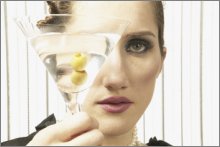Alcohol and Alcoholism in the U.S. --
The Shockingly High Numbers Revealed
by www.SixWise.com
Alcohol abuse and alcoholism is quietly taking its toll on Americans, according to a survey of over 43,000 people by the National Institute on Alcohol Abuse and Alcoholism (NIAAA).
|

One in three Americans say they have faced a drinking problem during
their lives.
|
"We found that 30.3 percent of the U.S. population at some time in their lives
-- though maybe not currently -- has had an alcohol use disorder," said study
author Bridget Grant of NIAAA's Division of Biometry and Epidemiology in an
ABC News article.
What's more, few among this group have received treatment for the condition, and those who did waited an average of eight years after their drinking problem started to get help.
In all, 42 percent of men and 19 percent of women surveyed said they had abused alcohol or faced alcoholism in their lifetime. Among ethnic groups, whites and Native Americans were more likely to report a drinking problem than other ethnicities.
The alcohol use disorders referred to in the survey refer to those who abused alcohol (binge drinking, etc.), and those who experienced dependency (alcohol addiction). More than half (17.8 percent) of the respondents reported a problem with alcohol abuse, while 12.5 percent reported alcohol dependence.
Alcoholism: What's the Difference Between Dependency and Abuse?
Alcoholism is the term used to describe alcohol dependency. This is a disease that, according to NIAAA, includes these four symptoms:
-
Craving: A strong need, or urge, to drink.
-
Loss of control: Not being able to stop drinking once drinking has begun.
-
Physical dependence: Withdrawal symptoms, such as nausea, sweating, shakiness, and anxiety after stopping drinking.
-
Tolerance: The need to drink greater amounts of alcohol to get "high."
Alcoholism is a chronic illness that can become all-consuming, and the cravings for alcohol experienced by an alcoholic can be as strong as those for food and water. The need to drink in an alcoholic will eventually, without treatment, surpass even health issues, family and work trouble, and legal problems.
Because there is currently no "cure" for alcoholism, not drinking at all is necessary for the person's lifetime.
Alcohol abuse, on the other hand, describes someone who drinks too much, too often, yet is not dependent on alcohol. Alcohol abuse can:
-
Lead to problems meeting work, school or family responsibilities
-
Result in arrests and car accidents from drunk driving
-
Cause alcohol-related medical problems
Unlike with alcoholics, it is possible for an alcohol abuser to cut back on
their drinks (rather than eliminate them entirely) and still recover -- IF they
can learn to limit their alcohol intake to a responsible level.
|
Do You Have
a Drinking Problem?

If you answer "yes" to one of these questions, it's possible you have
an alcohol problem, according to NIAAA. If you answer "yes" to more than
one, a drinking problem is highly likely.
-
Have you ever felt you should cut down on your drinking?
-
Have people annoyed you by criticizing your drinking?
-
Have you ever felt bad or guilty about your drinking?
-
Have you ever had a drink first thing in the morning to steady your
nerves or to get rid of a hangover?
|
Treatment Options for Alcoholics
While treatment options, from counseling to medications, do exist, the study found that just 24 percent of those suffering from alcohol dependency -- and 7 percent of those suffering from alcohol abuse -- seek help.
"One of the major findings of the study is that the proportion of people seeking or receiving professional treatment was unchanged or declined in the last 10 years -- and it is a small proportion of people who develop the disorder," said Dr. Mark Willenbring, director of the Treatment and Recovery Research Division of the National Institutes of Health in an ABC News article.
The reasons why so few people seek help for alcohol problems are varied, ranging from the stigma involved to no insurance coverage to believing they have their drinking under control, or that treatment won't help.
However, among those who do get help, the results are usually positive.
"The good news is that the majority of people who seek treatment, or even who don't seek professional treatment but try to change their behaviors, are eventually successful," Willenbring said.
What treatment options are available? A wide variety, including:
-
12-step programs like Alcoholics Anonymous (AA)
-
Visiting a doctor
-
Crisis centers
-
Employee-assistance programs
-
Medications to reduce cravings for alcohol, reduce symptoms of withdrawal and abstinence, and even discourage drinking by making the person feel sick when they drink alcohol
The best treatment options vary by individual, and often it requires a mix of options, sometimes repeated, to overcome the disease.
If you or a loved one needs help for a drinking problem, the following resources can help:
You may now be wondering, what is an acceptable drinking level for healthy adults? According to NIAAA, most adults can use alcohol moderately -- meaning up to two drinks per day for men and one drink per day for women and older people -- and not experience problems. (One drink equals one 12-ounce bottle of beer or wine cooler, one 5-ounce glass of wine, or 1.5 ounces of 80-proof distilled spirits.)
Recommended Reading
Alcohol Consumption-How Much is Too Much and Too Little?
How True IS the Phrase 'In Vino Veritas' ('In Wine There Is Truth')?
Archives of General Psychiatry July 2007;64:830-842
National Institute on Alcohol Abuse and Alcoholism
ABC News July 2, 2007
CBS News July 2, 2007